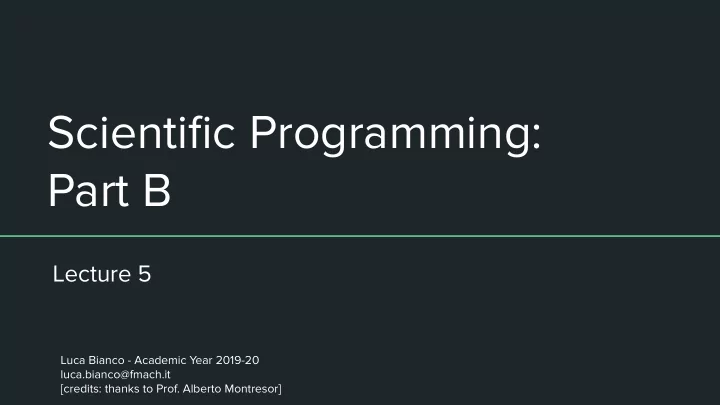

Scientific Programming: Part B Lecture 5 Luca Bianco - Academic Year 2019-20 luca.bianco@fmach.it [credits: thanks to Prof. Alberto Montresor]
Dictionary: ADT
Possible implementations of a dictionary
Hash table: definitions Key Function Hash table 0 1 3 Luca Bianco ... David Leoni 60 ... Massimiliano Luca 116 ... m-1
Hash table: collisions Key Function Hash table 0 collision 1 3 Luca Bianco ... There are several David Leoni 60 ways to deal ... Massimiliano Luca with these... 116 Andrea Passerini ... m-1
Direct access tables Example: days of the year
Perfect hash function
Hash functions we will have to deal with collisions anyway. More on this later...
Hash functions
Hash functions: possible implementations
Hash functions: possible implementations (the code) ord → ascii representation of a character Replace the b that stands for binary!
Hash function implementation Luca 1,282,761,569 mod 383 Index: 351 David 293,692,926,308 mod 383 Index: 345 Massimiliano 23,948,156,761,864,131,868,341,923,439 mod 383 Index: 208 Andrea 71,942,387,426,657 mod 383 Index: 111 Alberto 18,415,043,350,787,183 mod 383 Index: 221 Alan Turing 39,545,995,566,905,718,680,940,135 mod 383 Index: 314
Conflicts: separate chaining
Separate chaining: complexity
Separate chaining: complexity
Separate chaining: complexity
Hash table: rules for hashing objects [https://www.asmeurer.com/blog/posts/what-happens-when-you-mess-with-hashing-in-python/]
Hash table: sample code (m = 11) [[('Andrea', 15)], [ ('Luca', 27), ('David', 5), ('Alberto', 12) ], [], [], [('Alan', 1)], [], [('Massimiliano', 12)], [], [], [], []] pair to deal with collisions Luca -> 27 Thomas -> None [[('Andrea', 15)], [ ('David', 5), ('Alberto', 12) ], [], [], [('Alan', 1)], [], [('Massimiliano', 12)], [], [], [], []] SOME CONFLICTS!
Hash table: sample code (m = 17) [[], [], [], [], [], [], [('Alan', 1)], [], [], [('Andrea', 15)], [], [], [('David', 5)], [('Massimiliano', 12)], [], [('Luca', 27)], [('Alberto', 12)]] Luca -> 27 Thomas -> None [[], [], [], [], [], [], [('Alan', 1)], [], [], [('Andrea', 15)], [], [], [('David', 5)], [('Massimiliano', 12)], [], [], [('Alberto', 12)]] NO CONFLICTS!
In python...
Python built-in: set
Python built-in: dictionary
Stack: Last in, first out queue
Stack: Last in, first out queue
Stack: Last in, first out queue
Stack: Last in, first out queue my_func(80)
Stack: Last in, first out queue my_func(20) my_func(80)
Stack: Last in, first out queue my_func(5) my_func(20) my_func(80)
Stack: Last in, first out queue my_func(1) my_func(5) my_func(20) my_func(80)
Stack: Last in, first out queue 1 my_func(1) my_func(5) my_func(20) my_func(80)
Stack: Last in, first out queue 6 my_func(5) my_func(20) my_func(80)
Stack: Last in, first out queue my_func(20) 26 my_func(80)
Stack: Last in, first out queue 106 my_func(80)
Stack: Last in, first out queue 106
Stack: Last in, first out queue Note : the stack has finite size!
Stack: implementation could have used a deque, linked list,...
Stack: uses
Stack: exercise Ideas on how to implement par_checker using a Stack? Simplifying assumption: only characters allowed in input are ”{ [ ( ) ] }” Possible solution: Loop through the input string and... ● push opening parenthesis to stack ● when analyzing a closing parenthesis, Desired output pop one element from the stack and {{([][])}()} balanced: True compare: if matching keep going, else [{()] balanced: False return False {[(())][{[]}]} balanced: True {[(())][{[]}] balanced: False
Stack: exercise Desired output {{([][])}()} balanced: True [{()] balanced: False {[(())][{[]}]} balanced: True {[(())][{[]}] balanced: False
Queue: First in, first out queue (FIFO)
Queue: example
Queue: uses and implementation
Queue: as a list (with deque) Not very interesting implementation. Just pay attention to the case when the Queue is empty in top and dequeue Makes use of efficient deque object that provides ~ O(1) push/pop https://docs.python.org/3.7/library/collections.html#collections.deque
Queue as a circular list tail tail tail tail
Queue as a circular list: example
Queue as a circular list: example
Queue as a circular list: example
Queue as a circular list: example
Queue as a circular list: example
Queue as a circular list: example
Queue as a circular list: example skipping a few typing steps...
Queue as a circular list: example skipping a few typing/reading steps...
Queue as a circular list: exercise Implement the CircularQueue data structure (without going to the next slide…)
Queue as a circular list: the code
Exercise 1 Consider the following code (where s is a list of n elements). What is its complexity?
Exercise 1 Consider the following code (where s is a list of n elements). What is its complexity? strings are immutable!
Exercise 2 Consider the following code (where s is a list of n elements). What is its complexity?
Exercise 2 Consider the following code (where s is a list of n elements). What is its complexity?
Exercise 3 Consider the following code (where s is a list of n elements). What is its complexity?
Exercise 3 Consider the following code (where s is a list of n elements). What is its complexity? Note that: “”.join(res) has complexity O(n)
Exercise 4 Consider the following code (where L is a list of n elements). What is its complexity?
Exercise 4 Consider the following code (where L is a list of n elements). What is its complexity?
Exercise 5 Consider the following code (where L is a list of n elements). What is its complexity?
Exercise 5 Consider the following code (where L is a list of n elements). What is its complexity?
Recommend
More recommend